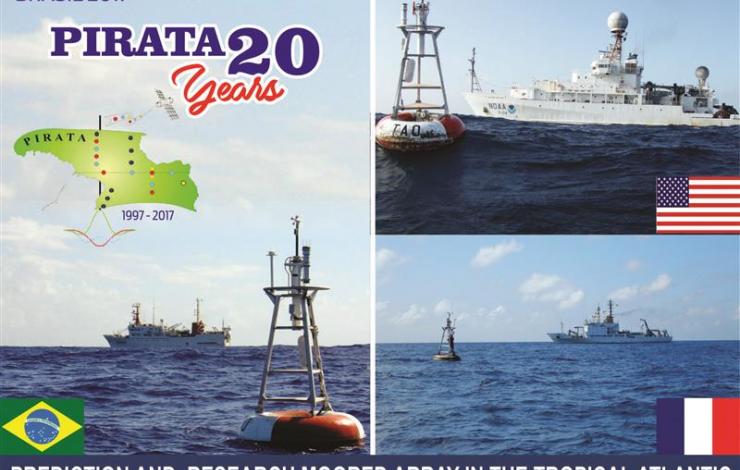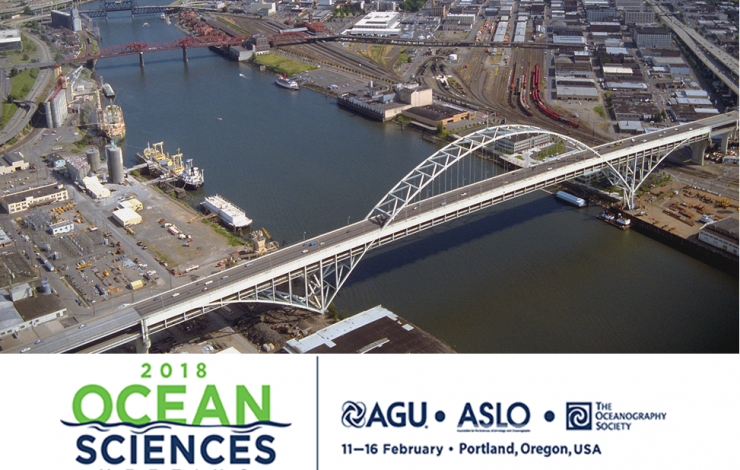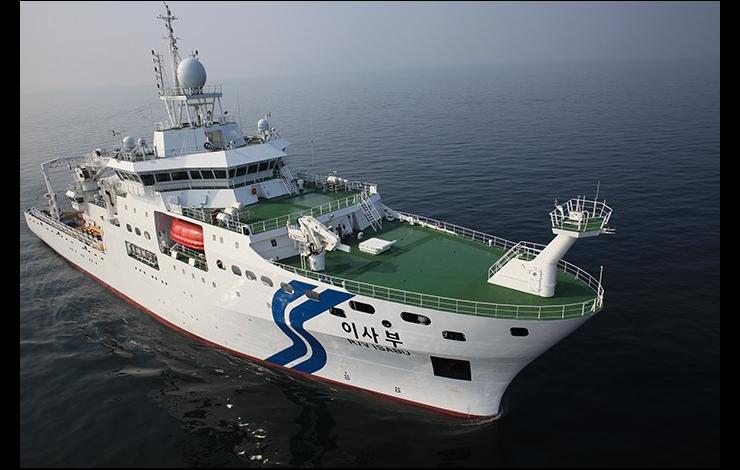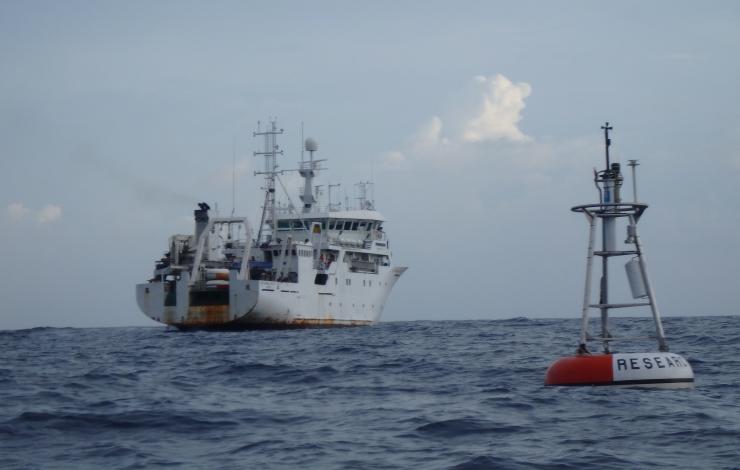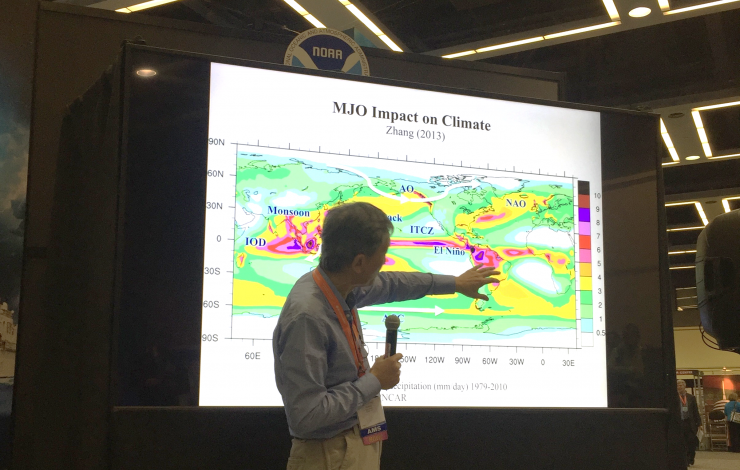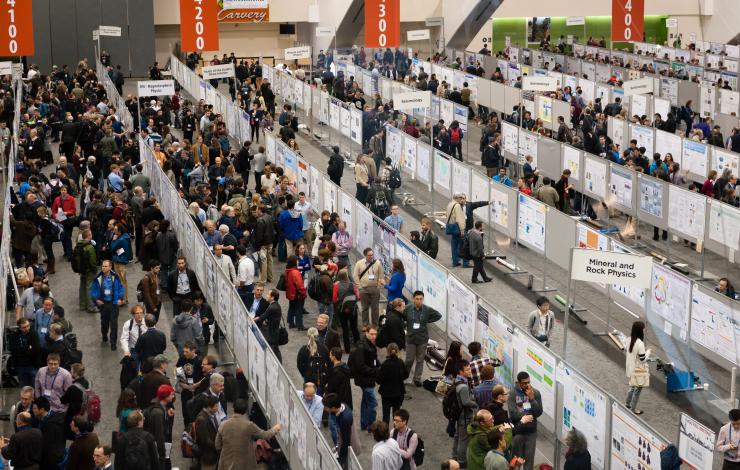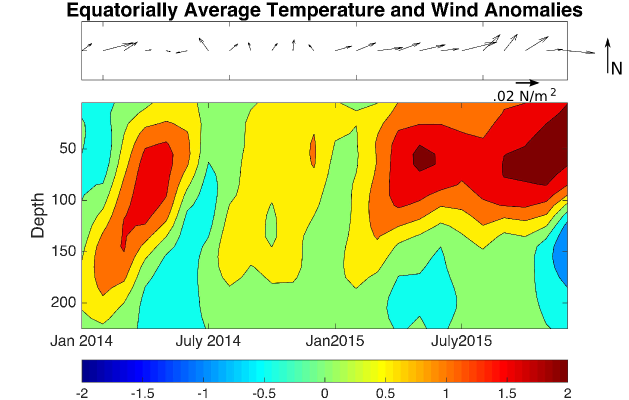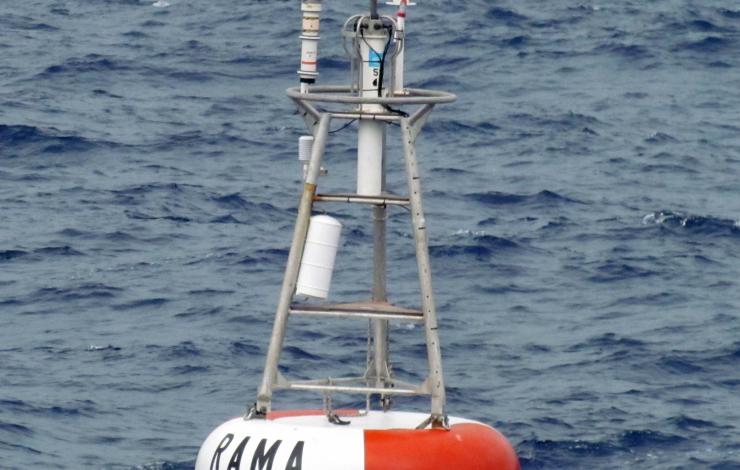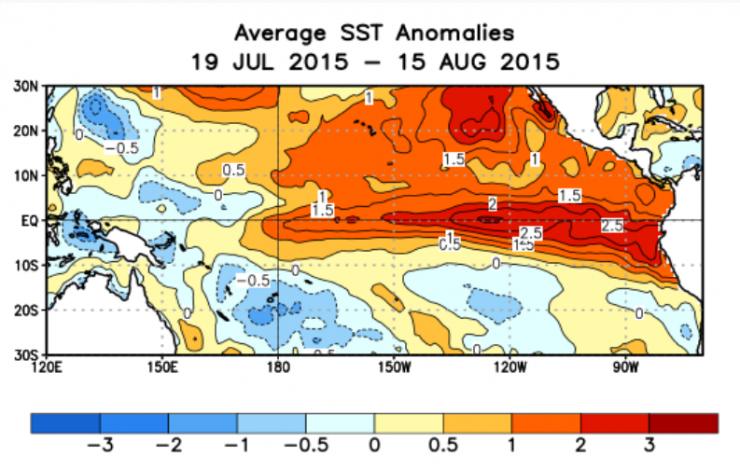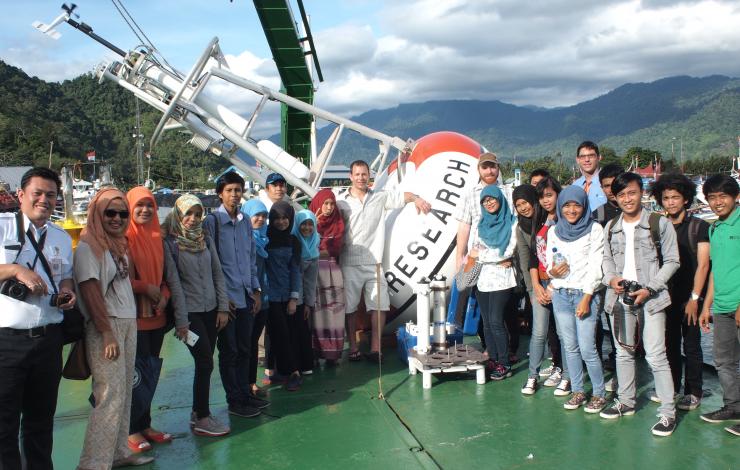What's New Archive
NOAA Ship Ronald H. Brown steamed out of Charleston, South Carolina, on February 16, 2018 for a multi-stage trip around the world to improve ocean data that informs United States and global weather prediction.
Ron Brown's first mission will be to investigate ocean currents in the North Atlantic Ocean that influence global climate. From there, NOAA's ocean workhorse will journey south to the tropical Atlantic Ocean to replace four instrumented observing moorings in the Prediction and Research Moored Array in the Atlantic or PIRATA. The PIRATA moorings are part of a larger tropical observing system of buoys that provides ocean and atmospheric data that helps the U.S. and other nations predict droughts, floods, hurricanes and other weather affecting millions of people in the Americas and Africa.
Brazil recently issued an official postage stamp with photographs of the Ron Brown and vessels from Brazil and France to celebrate 20 years of collaboration between Brazil, France and the United States on the PIRATA ocean observing system.
See full article here.
28 talks will present research on ocean carbon, ocean acidification, ocean observing systems, Arctic research including the Distributed Biological Observatory and Arctic Marine Pulses (AMP), ENSO, MJO, hydrothermal vents, Saildrone research, air-sea interactions, SOCCOM, and ocean mixing. 26 posters will be up during the poster sessions and highlight research in the Arctic, hydrothermal vents, acoustics, methane bubbles and hydrates, Saildrone, Oculus Coastal Glider, ocean carbon, deep ocean temperatures, glider research in the Solomon Sea, and ocean acidification and hyopxia.
PMEL staff will also be chairing sessions and workshops on:
- El Nino-Southern Oscillation (ENSO) Diversity, Predictability, and Impacts
- Western Pacific and Indonesian Sea Circulation and Its Environmental and Climatic Impacts
- New Platform and Sensor Technologies: Advancing Research, Readiness, and Transitioning for Sustained Ocean Observing of Essential Ocean Variables
- Methane from the Subsurface Through the Bio-, Hydro-, and Atmosphere: Advances in Natural Hydrate Systems and Methane Seeps in Marine Ecosystems
- Cascadia Margin methane seep and hydrates to share results and coordinate future work
The 2018 Ocean Sciences Meeting is co-sponsored by the American Geophysical Union (AGU), the Association for the Sciences of Limnology and Oceanography (ASLO), and The Oceanography Society (TOS). The meeting is an important venue for scientific exchange across broad marine science disciplines. Sessions will include all aspects of oceanography, especially multidisciplinary topics, as well as presentations that reflect new and emerging research on the global ocean and society, including science education, outreach, and public policy
July 2 - July 26: The Research Moored Array for African-Asian-Australian Monsoon Analysis and Prediction (RAMA) in the Indian Ocean began in 2004 as an international effort to improve understanding and ability to predict variability associated with the monsoon system. The array is now 78% complete and continues to grow through the formation of new partnerships.
The newest RAMA partnership is between NOAA and the Korea Institute of Ocean Science and Technology (KIOST). KIOST recently launched a new all purpose research vessel, the R/V Isabu, and is conducting a cruise in partnership with NOAA/PMEL to service three RAMA moorings along 67°E in throughout July 2017. Initial planning has also commenced for an Indian Ocean-Climate Workshop in Korea in late 2017 to identify common themes for a collaborative Korea-US research program over the next five years. The KIOST-NOAA Partnership is an exciting development to facilitate exchange of ideas and sharing of resources for advancing Indian Ocean science.
RAMA complements other moored buoy arrays in the Atlantic (PIRATA) and Pacific (TAO/TRITON). To learn more about RAMA, visit PMEL’s Global Tropical Moored Buoy Array’s website here.
PMEL’s Global Tropical Moored Buoy Array group has begun the 2017 field season of the Research Moored Array for African-Asian-Australian Monsoon Analysis and Prediction (RAMA) in the Indian Ocean.
PMEL scientists and engineers just finished participating in the collaborative US-Indonesian research cruise aboard the Indonesian research vessel Baruna Jaya VIII in support of the RAMA array. Dr. Michael McPhaden, Tim Nesseth, and William Higley (from the University of Washington’s Joint Institute for the Study of the Ocean and Atmosphere) serviced 5 RAMA moorings along 90°E. The cruise left Jakarta on February 20 and returned to Jakarta on March 16 with a mid-cruise port call in Sabang on northern Sumatra. During the mid-cruise port stop in Mike McPhaden briefed local and regional officials from the Indonesian Agency for Meteorology, Climatology, and Geophysics (BMKG), which partners with NOAA in maintaining RAMA buoys in the eastern Indian Ocean.
RAMA is an international effort to improve understanding and ability to predict of the African-Asian-Australian monsoon system. It complements other moored arrays in the Atlantic (PIRATA) and Pacific (TAO/TRITON) Oceans. Since RAMA began in 2004, the array has since grown through the formation of new partnerships and is now 78% complete. To learn more about RAMA, visit PMEL’s Global Tropical Moored Buoy Array’s website here.
Last week, PMEL scientists attended the American Meteorological Society (AMS)’s Annual Meeting in Seattle, WA and the Alaska Marine Science Symposium (AMSS) in Anchorage, AK. Presentations covered research in the Bering Sea, data management and access, El Nino, sea ice, the Earth's energy imbalance, innovative technologies, and recent warming in the Pacific and others.
At AMSS, the Ecosystems and Fisheries-Oceanography Coordinated Investigations (EcoFOCI) group had multiple presentations and posters on the Bering Sea including topics on the recent marine heat wave in Alaska, linking annual oceanographic processes to contiguous ecological domains in the pacific Arctic, fish distributions, ecology, Saildrone and oceanography.
A wider range of topics were covered at AMS and included invited talks from Nick Bond, Chidong Zhang and Kevin Wood. Dr. Zhang spoke about the Dynamics of the Madden-Julian Oscillation; Kevin Wood presented the Old Weather Project using historical U.S. ship logbooks to collect and analyze historical climate data; and Nick Bond discussed the recent warming in the NE Pacific. The annual meeting is the world’s largest yearly gathering for the weather, water, and climate community and brings together atmospheric scientists, professionals, students, educators and research’s from around the world. AMS is the nation’s premier scientific and professional organization promoting and disseminating information about the atmospheric, oceanic, hydrologic sciences.
Learn more about all our different research themes and groups here.
PMEL scientists, including scientists from the University of Washington's Joint Institute for the Study of the Ocean and Atmosphere (JISAO) and Oregon State University's Cooperative Institute for Marine Resources Studies (CIMRS) are attending the American Geophysical Union (AGU)’s Annual Meeting in San Francisco this week, December 12-16. AGU's Falling Meeting is the largest Earth and space science meeting in the world bringing together the Earth and space science community for discussions of emerging trends and the latest research. Poster and talk topics include data integration, El Nino Southern Oscillation (ENSO), Indian Ocean temperature trends, hydrothermal plumes and vents, carbon dioxide in the tropics and Gulf of Alaska, aerosol research, and heat impacts on marine ecosystems and fisheries, tsunamis, and acoustic research.
The 2016 Arctic Report Card will be released Tuesday morning in conjunction with a press conference led by NOAA’s Jeremy Mathis. The 2016 Arctic Report Card brings together the work of 61 scientists from 11 nations to provide the latest information on multiple measures of Arctic environmental change, including air and sea surface temperature, sea ice, snow cover, vegetation, wildlife, and plankton abundance. Read the full report and highlights here as well as the press release. Watch the recorded press conference here.
Researchers will also present during a press conference Thursday morning some of the first scientific results from the 2015 Axial Seamount eruption including discoveries of previously unknown structures and new glimpses into the volcano’s internal plumbing. These new insights into the world’s most active and well-studied underwater volcano may help scientists better understand all volcanoes and the hazards they pose. Read the press release here. Watched the recorded press conference here.
Dr. Bob Embley from the Earth-Ocean Interactions group will be honored during the Awards Ceremony as part of the 2016 class of Fellows for his pioneering contributions to the understanding of deep-sea volcanism by fostering interdisciplinary investigations with advanced technologies.
PMEL climate scientists describe in a recently published paper the relationship between the 2014-15 failed El Niño and this year’s monster El Niño as well as any similarities between the past strong El Niño’s. They examined changes in sea surface and sub-surface temperatures, winds, and volumes of warm water in the Pacific Ocean from 2014 to 2016.
What they found was that the highly anticipated 2014-15 El Niño event failed due to unusually strong easterly winds in the summer of 2014 which prevented the warm surface water from shifting eastward as seen in a typical El Niño events and left a reservoir of warm water below the ocean’s surface. This reservoir of warm water combined with strong westerly winds that appeared and continued throughout the spring and summer of 2015 led to the monster El Niño. They found a similar series of events that led to the 1991-92 El Nino event.
Learn more about El Nino Research and read AGU’s press release on the paper.
A new RAMA site was recently established near 4S 57E. Charter vessel TETHYS SUPPORTER deployed the mooring to bring the completion of the RAMA array to 76%.
Research and commentary articles just published online in Nature Climate Change by NOAA/PMEL Senior Scientist Michael McPhaden and collaborators highlights the need for continued study into El Niño causes and effects.
McPhaden’s commentary explores possible reasons why the much anticipated El Niño of 2014 failed to materialize, while an unforeseen strong El Niño is developing now. In the same issue, a review paper by McPhaden and colleagues explores the connection between global warming and El Niño/La Niña events. Model results indicate that extreme El Niño and La Niña events will increase in number and intensity as the climate continues to warm.
Read the commentary and research review on Nature Climate Change and the NOAA Press Release about current El Niño research.
PMEL Tropical Moored Buoy Array technicians Patrick Berk and Bill Higley recently completed a collaborative RAMA cruise aboard Indonesian Research Vessel Baruna Jaya 1. While in Indonesia, they participated in formal ceremonies celebrating the pending bilateral agreement between PMEL and Indonesia's meteorology and climatology agency, BMKG. This cruise marked a new phase of U.S. – Indonesian cooperation to better understand ocean-climate variability and how it affects the planet, and builds on years of cooperation between the two countries.
The RAMA array of surface and subsurface moorings in the Indian Ocean complements NOAA’s tropical moored arrays in the Atlantic Ocean, the Prediction and Research Moored Array in the Tropical Atlantic (PIRATA), and in Pacific Ocean, the Tropical Atmosphere Ocean (TAO) array, and Japans Triangle Trans-Ocean Buoy Network (TRITON). RAMA will improve description, understanding, and prediction of Asian monsoons, which affect one third of the world’s population. Learn more about the Global Tropical Moored Buoy Array group.



